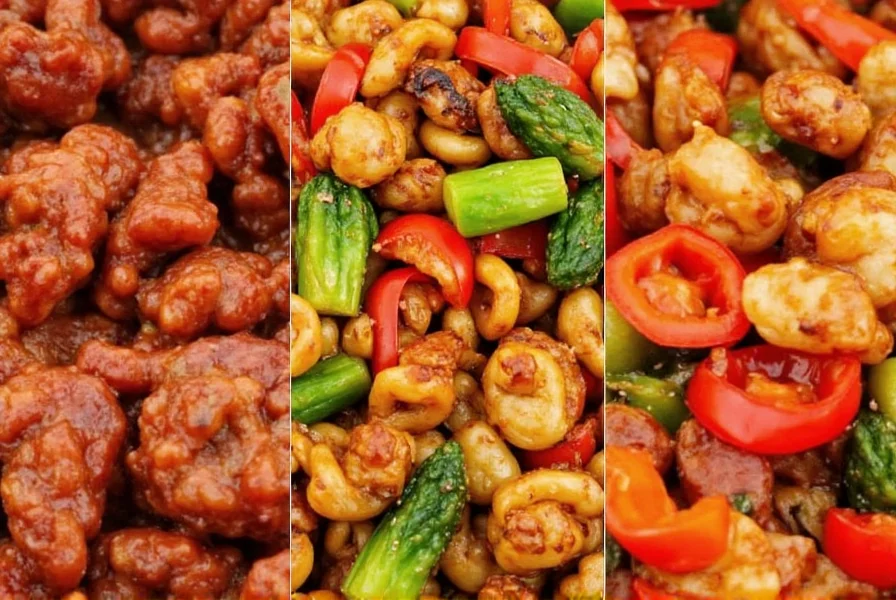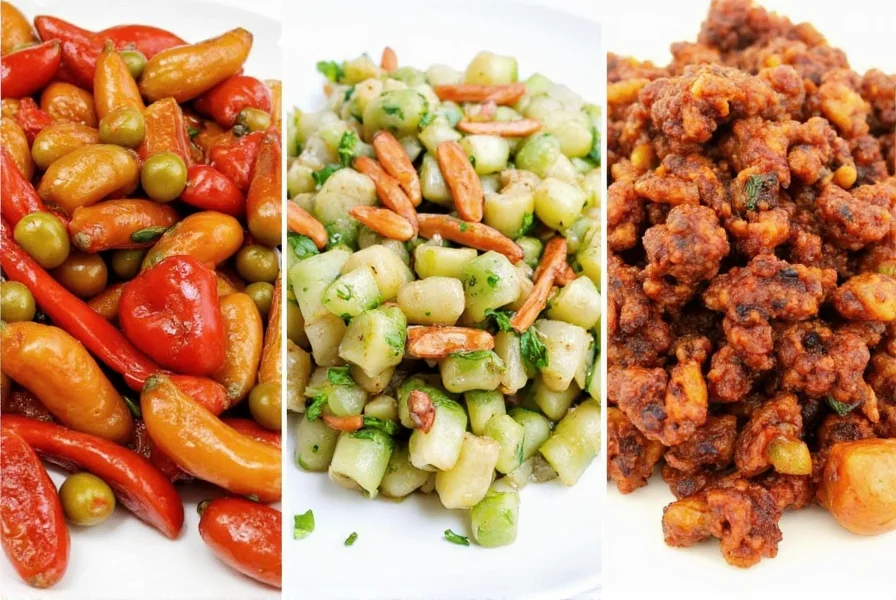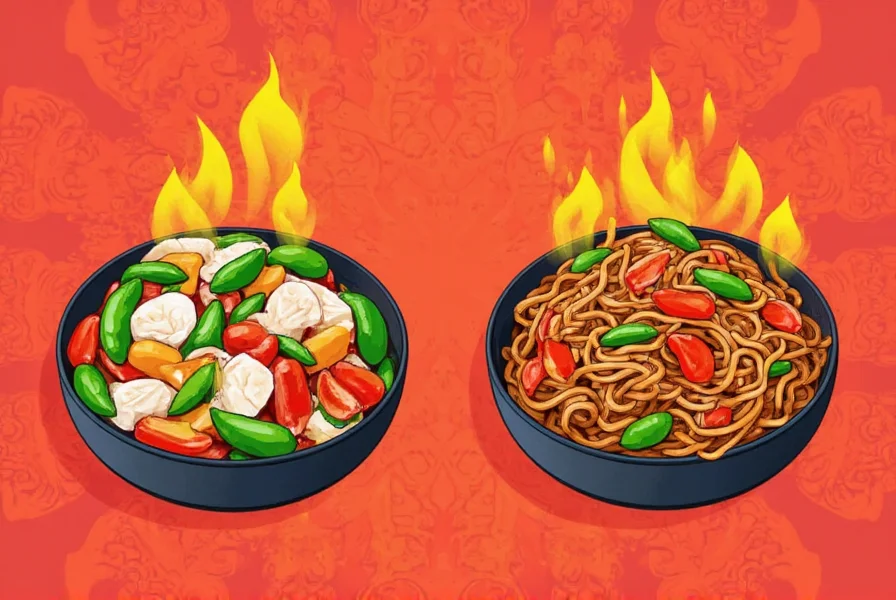Table of Contents
- Introduction
- Heat Profiles Compared
- Flavor Characteristics
- Cultural Roots & Regional Influence
- Practical Cooking Tips
- Buying Guide: Essential Ingredients
- Pairing Suggestions
- Frequently Asked Questions
- Conclusion
Introduction
Here's a clear comparison of Hunan, Szechuan, and Kung Pao cuisines: Hunan features direct, intense heat from fresh chilies, Szechuan delivers a numbing-spicy "ma la" sensation from Sichuan peppercorns, and Kung Pao is a specific stir-fry dish with a balanced sweet-sour-spicy profile. This guide provides accurate, expert-backed insights into their key differences, origins, and authentic preparation methods for home cooking.
Heat Profiles Compared
Each cuisine offers distinct heat experiences based on regional ingredients and techniques:
- Hunan: Raw, intense heat from fresh red chilies with minimal numbing effects.
- Szechuan: Signature "ma la" (numbing and spicy) sensation from Sichuan peppercorns combined with dried chilies.
- Kung Pao: Balanced heat with sweet, sour, and moderate spice elements, not purely focused on intensity.
| Style | Main Spice Source | Taste Profile | Mouthfeel |
|---|---|---|---|
| Hunan | Fresh red chilies | Bold, fiery, earthy | Dry, upfront heat |
| Szechuan | Sichuan peppercorns + dried chilies | Pungent, tingly, complex | Numb-inducing, lingering burn |
| Kung Pao | Dried chilies + mild pepper mix | Sweet, nutty, mildly spicy | Smoky-savory finish |
Flavor Characteristics
Each style evolved from regional needs and traditions, shaping unique flavor profiles:
- Hunan cuisine (Xiang cuisine) developed in China's humid Hunan province. Locals used fresh chilies to stimulate appetite and combat humidity, resulting in bold, direct heat with minimal sweet or sour elements.
- Szechuan cuisine (Sichuanese cuisine) originated in mountainous Sichuan province. Preservation needs led to fermented ingredients and Sichuan peppercorns, creating the iconic "ma la" sensation that defines authentic dishes.
- Kung Pao (Gong Bao) is a specific stir-fry dish created during the Qing Dynasty. It combines chicken, peanuts, vegetables, and a sauce balancing sweet, sour, and moderate spice—distinct from broader Szechuan cuisine despite its regional roots.

Cultural Roots & Regional Influence
Understanding historical context explains why these flavors developed:
- Hunan: Humid climate drove use of fresh chilies for appetite stimulation and sweating. Traditional dishes like "Loudou" (spicy stir-fried pork) showcase minimal sweet/sour balance for pure heat.
- Szechuan: Mountainous terrain required food preservation techniques. Fermented black beans, pickled vegetables, and Sichuan peppercorns became staples, creating complex "ma la" profiles in dishes like Mapo Tofu.
- Kung Pao: Created by Governor Ding Baozhen in Sichuan province. It blends local Sichuan ingredients with sweet-sour elements from other regions, resulting in a dish distinct from typical Sichuan cuisine due to its balanced, non-numbing heat.
Practical Cooking Tips for Each Style
Authentic preparation requires specific techniques and ingredients:
- Hunan-style: Use fresh red chilies (not dried) for maximum heat. Cook quickly over high heat to preserve freshness. Avoid sweeteners or vinegar to maintain bold, earthy flavor.
- Szechuan-style: Toast whole Sichuan peppercorns before grinding to release essential oils. Combine with dried chilies and fermented black beans for authentic "ma la" depth. Balance heat with soy sauce and rice wine.
- Kung Pao-style: Focus on balance: add sugar and vinegar to offset spice. Use peanuts for crunch and dried chilies for mild heat. Stir-fry ingredients rapidly to prevent overcooking.
Buying Guide: Essential Ingredients
For authentic results, prioritize quality ingredients:
1. Sichuan Peppercorns
- Features: Vibrant aroma, tingling numbing effect, high-quality grade
- Best For: stir-fries, marinades, dry pots
- Usage Tip: Toast whole peppercorns before grinding for maximum impact; store in a cool, dark place.
2. Hunan Chili Paste
- Features: Fermented richness, robust heat, minimal additives
- Best For: braises, soups, hot pot bases
- Usage Tip: Use sparingly—fermented pastes concentrate flavor. Ideal for slow-cooked dishes to develop depth.

3. Kung Pao Seasoning Blend
- Features: Balanced blend of spices, includes dehydrated garlic and ginger
- Best For: quick meals, wok dishes, weeknight dinners
- Usage Tip: Combine with soy sauce and rice vinegar for an instant glaze. Avoid over-sweetening to maintain authenticity.
4. Chinkiang Black Vinegar
- Features: Rich umami, slight sweetness, traditional fermentation
- Best For: Kung Pao sauce, dipping sauces, dumpling accompaniments
- Usage Tip: Use sparingly—very concentrated flavor. Add at the end of cooking for brightness.
5. Sesame Oil
- Features: Nutty aroma, rich flavor, non-GMO
- Best For: finishing touches, dressings, stir-fries
- Usage Tip: Always add at the end to preserve fragrance. Avoid high-heat cooking.
Pairing Suggestions
Enhance your meal with complementary beverages:
- Hunan Dish: Pair with jasmine tea or a crisp lager beer to cut through heat and oil.
- Szechuan Dish: Match with oolong tea or a light-bodied white wine like Riesling to complement numbing sensations.
- Kung Pao Dish: Enjoy with a citrus-forward IPA or sparkling water with lime to balance sweet-spicy notes.
Frequently Asked Questions
What's the main difference between Hunan and Szechuan cuisine?
Hunan cuisine features direct, intense heat from fresh chilies with minimal numbing effects, while Szechuan cuisine creates a "ma la" (numbing and spicy) sensation using Sichuan peppercorns. Hunan dishes emphasize bold, earthy flavors with little sweet/sour balance, whereas Szechuan cuisine incorporates fermented ingredients like black beans for complex depth.
Is Kung Pao a regional cuisine or a specific dish?
Kung Pao is a specific stir-fry dish, not a regional cuisine. It originated in Sichuan province during the Qing Dynasty but has a distinct sweet-sour-spicy profile that differs from typical Sichuan dishes like Mapo Tofu. Authentic Kung Pao includes chicken, peanuts, vegetables, and a balanced sauce—unlike broader Sichuan cuisine which focuses on numbing "ma la" flavors.
Which is spicier: Hunan or Szechuan?
Hunan cuisine typically delivers more direct heat intensity from fresh chilies, while Szechuan cuisine combines moderate heat with numbing effects from Sichuan peppercorns. The overall sensation in Szechuan dishes can feel more intense due to the numbing component, but Hunan provides straightforward, upfront heat without the "tingly" sensation.
What causes the numbing sensation in Szechuan food?
The numbing sensation comes from Sichuan peppercorns (huājiāo), which contain hydroxy-alpha-sanshool. This compound triggers a tingling, vibrating sensation on the lips and tongue rather than pure heat. It's a defining characteristic of authentic Sichuan cooking and complements spicy elements for the "ma la" experience.
Can I adjust the spice level while maintaining authenticity?
Yes, authenticity comes from technique and ingredient balance, not maximum heat. For Hunan dishes, reduce fresh chilies but maintain cooking methods. For Szechuan, decrease peppercorns and chilies proportionally while preserving fermented elements. For Kung Pao, adjust dried chilies while keeping sugar-vinegar balance. Traditional Chinese restaurants often tailor spice levels to preferences without compromising core flavors.
What should I drink to cool down after eating spicy Chinese food?
Dairy products like milk or yogurt are most effective for neutralizing heat due to casein. Traditional pairings include jasmine tea for Hunan dishes (cuts through oil), oolong tea for Szechuan (complements numbing), and light beers for Kung Pao (balances sweet-spicy). Avoid alcohol and carbonated drinks, which intensify burning sensations.
Conclusion
Understanding the distinctions between Hunan, Szechuan, and Kung Pao cuisines empowers you to cook and order with confidence. Hunan delivers direct, fiery heat; Szechuan offers complex numbing-spicy depth; and Kung Pao provides a balanced sweet-sour-spicy profile. By focusing on authentic ingredients and techniques, you can recreate these regional specialties at home while respecting their cultural origins.
Grab your wok, source quality ingredients, and explore the rich diversity of Chinese culinary traditions.











 浙公网安备
33010002000092号
浙公网安备
33010002000092号 浙B2-20120091-4
浙B2-20120091-4